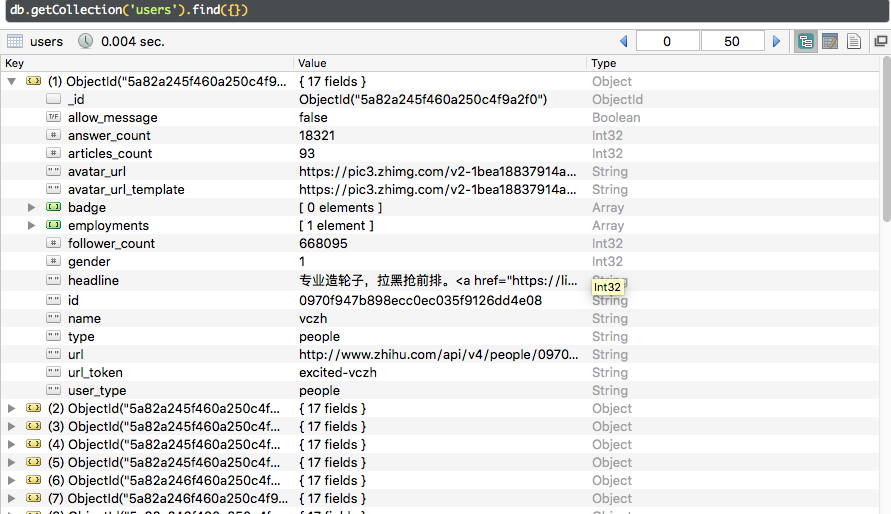利用 Scrapy 爬取知乎用户信息
思路:通过获取知乎某个大V的关注列表和被关注列表,查看该大V和其关注用户和被关注用户的详细信息,然后通过层层递归调用,实现获取关注用户和被关注用户的关注列表和被关注列表,最终实现获取大量用户信息。
一、新建一个scrapy项目
scrapy startproject zhihuuser
移动到新建目录下:
cd zhihuuser
新建spider项目:
scrapy genspider zhihu zhihu.com
二、这里以爬取知乎大V轮子哥的用户信息来实现爬取知乎大量用户信息。
a) 定义 spdier.py 文件(定义爬取网址,爬取规则等):
# -*- coding: utf-8 -*-
import json from scrapy import Spider, Request from zhihuuser.items import UserItem class ZhihuSpider(Spider):
name = 'zhihu'
allowed_domains = ['zhihu.com']
start_urls = ['http://zhihu.com/']
#自定义爬取网址
start_user = 'excited-vczh'
user_url = 'https://www.zhihu.com/api/v4/members/{user}?include={include}'
user_query = 'allow_message,is_followed,is_following,is_org,is_blocking,employments,answer_count,follower_count,articles_count,gender,badge[?(type=best_answerer)].topics'
follows_url = 'https://www.zhihu.com/api/v4/members/{user}/followees?include={include}&offset={offset}&limit={limit}'
follows_query = 'data[*].answer_count,articles_count,gender,follower_count,is_followed,is_following,badge[?(type=best_answerer)].topics' followers_url = 'https://www.zhihu.com/api/v4/members/{user}/followees?include={include}&offset={offset}&limit={limit}'
followers_query = 'data[*].answer_count,articles_count,gender,follower_count,is_followed,is_following,badge[?(type=best_answerer)].topics'
#定义请求爬取用户信息、关注用户和被关注用户的函数
def start_requests(self):
yield Request(self.user_url.format(user=self.start_user, include=self.user_query), callback=self.parseUser)
yield Request(self.follows_url.format(user=self.start_user, include=self.follows_query, offset=0, limit=20), callback=self.parseFollows)
yield Request(self.followers_url.format(user=self.start_user, include=self.followers_query, offset=0, limit=20), callback=self.parseFollowers) #请求爬取用户详细信息
def parseUser(self, response):
result = json.loads(response.text)
item = UserItem() for field in item.fields:
if field in result.keys():
item[field] = result.get(field)
yield item
#定义回调函数,爬取关注用户与被关注用户的详细信息,实现层层迭代
yield Request(self.follows_url.format(user=result.get('url_token'), include=self.follows_query, offset=0, limit=20), callback=self.parseFollows)
yield Request(self.followers_url.format(user=result.get('url_token'), include=self.followers_query, offset=0, limit=20), callback=self.parseFollowers) #爬取关注者列表
def parseFollows(self, response):
results = json.loads(response.text) if 'data' in results.keys():
for result in results.get('data'):
yield Request(self.user_url.format(user=result.get('url_token'), include=self.user_query), callback=self.parseUser) if 'paging' in results.keys() and results.get('paging').get('is_end') == False:
next_page = results.get('paging').get('next')
yield Request(next_page, callback=self.parseFollows) #爬取被关注者列表
def parseFollowers(self, response):
results = json.loads(response.text) if 'data' in results.keys():
for result in results.get('data'):
yield Request(self.user_url.format(user=result.get('url_token'), include=self.user_query), callback=self.parseUser) if 'paging' in results.keys() and results.get('paging').get('is_end') == False:
next_page = results.get('paging').get('next')
yield Request(next_page, callback=self.parseFollowers)
b) 定义 items.py 文件(定义爬取数据的信息,使其规整等):
# -*- coding: utf-8 -*- # Define here the models for your scraped items
#
# See documentation in:
# https://doc.scrapy.org/en/latest/topics/items.html from scrapy import Field, Item class UserItem(Item):
# define the fields for your item here like:
# name = scrapy.Field()
allow_message = Field()
answer_count = Field()
articles_count = Field()
avatar_url = Field()
avatar_url_template = Field()
badge = Field()
employments = Field()
follower_count = Field()
gender = Field()
headline = Field()
id = Field()
name = Field()
type = Field()
url = Field()
url_token = Field()
user_type = Field()
c) 定义 pipelines.py 文件(存储数据到MongoDB):
# -*- coding: utf-8 -*- # Define your item pipelines here
#
# Don't forget to add your pipeline to the ITEM_PIPELINES setting
# See: https://doc.scrapy.org/en/latest/topics/item-pipeline.html
import pymongo #存储到MongoDB
class MongoPipeline(object): collection_name = 'users' def __init__(self, mongo_uri, mongo_db):
self.mongo_uri = mongo_uri
self.mongo_db = mongo_db @classmethod
def from_crawler(cls, crawler):
return cls(
mongo_uri=crawler.settings.get('MONGO_URI'),
mongo_db=crawler.settings.get('MONGO_DATABASE')
) def open_spider(self, spider):
self.client = pymongo.MongoClient(self.mongo_uri)
self.db = self.client[self.mongo_db] def close_spider(self, spider):
self.client.close() def process_item(self, item, spider):
self.db[self.collection_name].update({'url_token': item['url_token']}, dict(item), True) #执行去重操作
return item
d) 定义settings.py 文件(开启MongoDB、定义请求头、不遵循 robotstxt 规则):
# -*- coding: utf-8 -*-
BOT_NAME = 'zhihuuser' SPIDER_MODULES = ['zhihuuser.spiders'] # Obey robots.txt rules
ROBOTSTXT_OBEY = False #是否遵守robotstxt规则,限制爬取内容。 # Override the default request headers(加载请求头):
DEFAULT_REQUEST_HEADERS = {
'Accept': 'text/html,application/xhtml+xml,application/xml;q=0.9,*/*;q=0.8',
'Accept-Language': 'en',
'User-agent': 'Mozilla/5.0 (Macintosh; Intel Mac OS X 10_11_6) AppleWebKit/537.36 (KHTML, like Gecko) Chrome/64.0.3282.140 Safari/537.36',
'authorization': 'oauth c3cef7c66a1843f8b3a9e6a1e3160e20'
} # Configure item pipelines
# See https://doc.scrapy.org/en/latest/topics/item-pipeline.html
ITEM_PIPELINES = {
'zhihuuser.pipelines.MongoPipeline': 300,
} MONGO_URI = 'localhost'
MONGO_DATABASE = 'zhihu'
三、开启爬取:
scrapy crawl zhihu
部分爬取过程中的信息

存储到MongoDB的部分信息:

利用 Scrapy 爬取知乎用户信息的更多相关文章
- 爬虫实战--利用Scrapy爬取知乎用户信息
思路: 主要逻辑图:
- 爬虫(十六):scrapy爬取知乎用户信息
一:爬取思路 首先我们应该找到一个账号,这个账号被关注的人和关注的人都相对比较多的,就是下图中金字塔顶端的人,然后通过爬取这个账号的信息后,再爬取他关注的人和被关注的人的账号信息,然后爬取被关注人的账 ...
- 基于webmagic的爬虫小应用--爬取知乎用户信息
听到“爬虫”,是不是第一时间想到Python/php ? 多少想玩爬虫的Java学习者就因为语言不通而止步.Java是真的不能做爬虫吗? 当然不是. 只不过python的3行代码能解决的问题,而Jav ...
- 使用python scrapy爬取知乎提问信息
前文介绍了python的scrapy爬虫框架和登录知乎的方法. 这里介绍如何爬取知乎的问题信息,并保存到mysql数据库中. 首先,看一下我要爬取哪些内容: 如下图所示,我要爬取一个问题的6个信息: ...
- Srapy 爬取知乎用户信息
今天用scrapy框架爬取一下所有知乎用户的信息.道理很简单,找一个知乎大V(就是粉丝和关注量都很多的那种),找到他的粉丝和他关注的人的信息,然后分别再找这些人的粉丝和关注的人的信息,层层递进,这样下 ...
- 利用Selenium爬取淘宝商品信息
一. Selenium和PhantomJS介绍 Selenium是一个用于Web应用程序测试的工具,Selenium直接运行在浏览器中,就像真正的用户在操作一样.由于这个性质,Selenium也是一 ...
- python scrapy爬取知乎问题和收藏夹下所有答案的内容和图片
上文介绍了爬取知乎问题信息的整个过程,这里介绍下爬取问题下所有答案的内容和图片,大致过程相同,部分核心代码不同. 爬取一个问题的所有内容流程大致如下: 一个问题url 请求url,获取问题下的答案个数 ...
- 利用Scrapy爬取所有知乎用户详细信息并存至MongoDB
欢迎大家关注腾讯云技术社区-博客园官方主页,我们将持续在博客园为大家推荐技术精品文章哦~ 作者 :崔庆才 本节分享一下爬取知乎用户所有用户信息的 Scrapy 爬虫实战. 本节目标 本节要实现的内容有 ...
- scrapy 爬取知乎问题、答案 ,并异步写入数据库(mysql)
python版本 python2.7 爬取知乎流程: 一 .分析 在访问知乎首页的时候(https://www.zhihu.com),在没有登录的情况下,会进行重定向到(https://www. ...
随机推荐
- 第七次作业:Beta阶段综合报告(Java-Team)
团队:Java-Team 成员: 章辉宇(284) 吴政楠(286) 陈阳(PM:288) 韩华颂(142) 胡志权(143) github地址:https://github.com/WHUSE201 ...
- java第5章学习总结
学号20145336 <Java程序设计>第5周学习总结 教材学习内容总结 try catch JVM会先尝试执行try区块中的内容,若发生错误且与catch后面的类型相符,则执行catc ...
- Flask 扩展 HTTP认证
Restful API不保存状态,无法依赖Cookie及Session来保存用户信息,自然也无法使用Flask-Login扩展来实现用户认证.所以这里,我们就要介绍另一个扩展,Flask-HTTPAu ...
- BM V7000数据恢复成功案例;服务器数据恢复
IBM V7000存储是一款定位中端的存储设备,很多企业选择该服务器作为存储,最近北亚数据恢复中心接到一例V7000服务器数据恢复案例,下面将对本次数据恢复的过程和数据恢复方法进行归纳总结,希望对各位 ...
- 从数据恢复角度解析RAID6结构原理
[什么是RAID] RAID的概念描述在互联网上比比皆是,用最简单的原理描述,就是在定义存储方式时允许在一部分数据缺失的情况下不影响全部数据,类似于通讯领域的纠错码.不同的冗余模式形成了不同的R ...
- Node入门教程(2)第一章:NodeJS 概述
Node 概述 什么是 Node Node.js® is a JavaScript runtime built on Chrome's V8 JavaScript engine. Node.js us ...
- 【技巧】Java工程中的Debug信息分级输出接口及部署模式
也许本文的标题你们没咋看懂.但是,本文将带大家领略输出调试的威力. 灵感来源 说到灵感,其实是源于笔者在修复服务器的ssh故障时的一个发现. 这个学期初,同袍(容我来一波广告产品页面,同袍官网)原服务 ...
- STM32F4系列单片机上使用CUBE配置MBEDTLS实现pem格式公钥导入
|版权声明:本文为博主原创文章,未经博主允许不得转载. 最近尝试在STM32F4下用MBEDTLS实现了公钥导入(我使用的是ECC加密),整个过程使用起来比较简单. 首先,STM32F4系列CUBE里 ...
- 如何修改chrome记住密码后自动填充表单的黄色背景 ?
input:-webkit-autofill, textarea:-webkit-autofill, select:-webkit-autofill { background-color: rgb(2 ...
- SSM中的登陆验证码
@Autowired private Producer captchaProducer = null; /** * 后台登录验证码 * @param request * @param response ...
